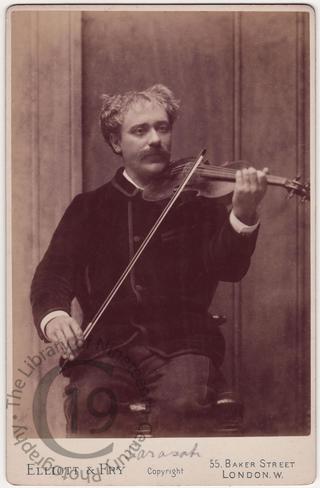
Pablo de Sarasate
A cabinet card portrait of the composer and violin virtuoso Pablo de Sarasate (1844-1908).
Born Pablo Martín Melitón de Sarasate y Navascuéz in Pamplona, in the Spanish province of Navarre, on 10 March 1844, Pablo began studying violin at the age of five with his father, an artillery bandmaster. He later took lessons from a local teacher, and gave his first concert in La Caruña when he was only eight years old.
Having been received with enthusiasm by his early audiences, a wealthy patron provided funding for Pablo’s parents to take him to Madrid to study with Manuel Rodríguez Saez. Within a short time he became a favourite performer at the court of Queen Isabel II. When Pablo was twelve, his mother decided to take him to Paris to study with Jean Alard at the Paris Conservatoire. However, his mother died of a heart attack on the train to Paris, and the Spanish authorities at Bayonne found Pablo was suffering from cholera. Fortunately, the Spanish consul at Bayonne took Pablo into his own home until he had recovered, and then financed the boy’s onward journey to Paris.
Once in Paris, Pablo auditioned for Monsieur Alard, who immediately recognized the boy’s musical talent. Although the youthful violinist could already have won all the honours of the Conservatoire, his teacher prudently held him back. When Pablo was seventeen, Alard agreed to let him enter the competition for the coveted Première Prix, which he easily won. With the Conservatoire’s highest honour, Pablo was guaranteed a career as a violinist.
At first Sarasate performed opera fantasies, most notably the Carmen fantasy, and other pieces that he himself had composed. Most of his own compositions ring with a Spanish flavour, and it was largely because of Sarasate that Spanish music gained such great favour among European composers of the time. Works such as Lalo’s Symphonie espagnole (dedicated to Sarasate), Bizet’s Carmen and Saint-Saëns' Introduction and Rondo Capriccioso (also dedicated to Sarasate) all show the clear influence of Spanish music. Sarasate's four volumes of Spanish dances for violin and piano have been favourites for generations, and his Zigeunerweisen for violin and orchestra is even today a concert standard.
Sarasate died of chronic bronchitis at his Biarritz home in 1908. He left most of his earthly goods to the city of Pamplona, where today there is a museum in his honour.
Photographed by Elliott and Fry of 55 Baker Street, London.
Code: 123568




